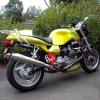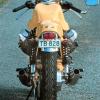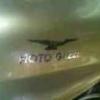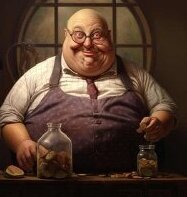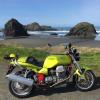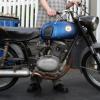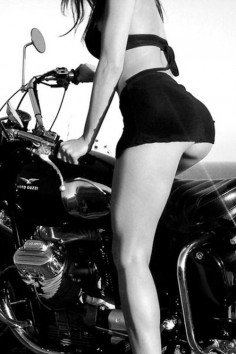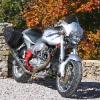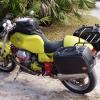Leaderboard
Popular Content
Showing content with the highest reputation on 03/27/2020 in all areas
-
So I decided to defer the tuning fuel tank job, just a bad time to do it really when you need to ship stuff and fitted up the fuel tank instead to do a leak check. Popped the injector connectors off and did repeated pump primes to pressurise the system and fill the lines. All good except for an externally leaking fuel tap when in the open position. These thing really are a POS. My original one jammed in the open position and this one inexplicably decides to leak from the shaft seal when open. Anyway I got my old one that had jammed open which I had after that event reworked somehow and fitted that. Hopefully it wont repeat the same defect. I then moved on to fitting the airbox so I could attack the side covers. The side cover fitment really is horrible on these bikes as they eventually crack due to the poor fitment strain. Need to have a think about solving this as I have 1 brand new cover to fit and one reworked one and I dont want them cracking. Couldn't resist fitting the tank and tailpiec to get an idea what its going to look like. Ciao6 points
-
the long-frame can be made to turn in alarmingly (dangerously?) quickly as i found out when piddling about with the fork/yolk height. 😮3 points
-
i re-installed my fast-idle lever today. thought everyone would like to know.2 points
-
2 points
-
2 points
-
2 points
-
So I guess, the V11 Playboy EE had very satisfied customers I love the translation quirks ! "Each Moto Guzzi was called a "character engine" in tests. A pet name for motorcycles where everything was wrong but it was forgiven because it was a Moto Guzzi. The finish of the machines was generally reasonable, but they were all wrong." - TRUE LOL "in 2001 the California 1100 EV80 was released, which was designed in collaboration with the furniture designer Poltrona Frau." - no wonder it handles like a couch "The Le Mans referred in name to the older Moto Guzzi Le Mans, whose production had already ended in 1993, but was less spectacular in design." - haha2 points
-
2 points
-
2 points
-
Well, the Americans have just about had it. They are demanding and end to this pandemic! OK...maybe not.2 points
-
Yes I'm happy with the way it looks. Raising the tank seems not to have had a negative impact. I might leave the rack off, initially anyway as my wife cant get pillion for the moment. I only had it fitted as a really good pillion hand hold. Its a great looking engine that's for sure, a look that engenders a feeling that danger may exist here. Bit like a big radial aircraft engine. When you know whats thrashing around inside one of those thing its a little bit worrying and scary. Ciao1 point
-
oh jaysus- i realise there’s a lot of ‘mericans on here- it’s not what you’re thinkin...1 point
-
1 point
-
1 point
-
Nope, not I. At least not that I remember but 1995 was a long, long time ago. I'm pretty sure the first time I saw the description used I smiled at how apposite it seemed.1 point
-
1 point
-
1 point
-
The term 'Pork Chop' was never derisive. It was a simple observation of the plates on early Spineys like the 1100 Sport C and Daytona 1000. They look like a pork chops! Well, sort of....... The name just stuck after the design changed and no longer had the 'Eye' in the middle. Even to this day, long after the Spineys and CARC bike's are historical artefacts if you ask their owners what the footpeg hanger plates are called most will call them 'Pork Chops' even if they don't know why. Its just another one of those 'Guzzi' things like the frame series of the big twins being called, Loop, Tonti, Spiney or CARC. Pete1 point
-
You’ll find those details further down here... At the end of the nineties appeared the rather extremely designed V 10 Centauro, a touring engine in which, however, the eight-valve engine from the 1000 Daytona was used. After this the eight-valve would disappear from the program again. The investments of Finprogetti (see "company") led immediately to the Moto Guzzi Sport 1100 Iniezione, the 1000 Daytona RS and the V10 Centauro, with the Sport 1100 in particular being a big improvement over its predecessor. Company The 10 million dollars that the sale of Benelli produced was largely put in the renewal of the production lines of Moto Guzzi by Alejandro de Tomaso. In 1996 the company of the Tomaso was renamed Trident Rowan Group. Moto Guzzi remained a part of it, but the company name became Moto Guzzi S.p.A. Until the nineties, all developments were done at Maserati, which was also part of the De Tomaso group back then. The Tomaso was in the mid-nineties still 51% owner of Moto Guzzi, but after the sale of Maserati started within the company doubts about the future and the development was taken back into its own hands. Because the development work had been outsourced to Maserati for many years, there was a backlog within the factory; for example, in 1994 there were already CAD equipment, but not enough staff to work with it. Production had fallen to 3,000 motorcycles a year in the mid-1990s. That was not due to the demand but to the defective production possibilities. This meant that importers and dealers could not meet the demand. In 1994 Moto Guzzi tried to take over the machinery of the bankrupt supplier Motoplat (electronic ignition), but the angry workers had already destroyed their machines. As a result, one had to go back to contact points for the Moto Guzzi 1000 Strada, among other things. In 1995, DTI (De Tomaso Group) bought the investment bank Finprogetti, which enabled new investments to be made in its own brand Moto Guzzi. In 1995, after 30 new employees were hired, an in-house development department was set up and 336 people were employed, 5.314 motorcycles were built again. Finprogetti appointed Arnolfo Sacchi as general manager, but in 1997 he was replaced by Oscar Cecchinato, who had previously worked at Aprilia. Together with technical director Angelo Ferrari he made plans to develop new models, but also to outsource large parts of the production to supply companies. There should even be liquid-cooled models. In 1998 there was a move to the former Philips factory in Monza and Moto Guzzi bought the concept of the 650cc-Gilera Nordwest with the intention to make a "Fun Bike". In addition, Piaggio agreed to supply a number of 125 and 180 cc engine blocks for scooters. Yet Moto Guzzi closed the nineties with a debt of 132 billion lire, more than 20 million Euro. There was a battle between Ducati and Aprilia to take over Moto Guzzi and even KTM was mentioned. In the spring of 1999, the former director of Ducati / Cagiva, Mario Scandellari, became director of Moto Guzzi. Model overview in the nineties l General In 2000, there was indeed the desire to release many new models, but no new technology came. Almost all new motorcycles were based on the California and the V 11 Sport. They all had fuel injection. The V 11 models arrived just in time to replace the then already failed V 10 Centauro. Each Moto Guzzi was called a "character engine" in tests. A pet name for motorcycles where everything was wrong but it was forgiven because it was a Moto Guzzi. The finish of the machines was generally reasonable, but they were all wrong. Very nicely designed dashboards were covered with beautiful lights that were barely readable, the spring settings were extensive, but the swivels to adjust the suspension almost unreachable. The jiffy always stood too far forward so that he was barely folded in or out on the motorcycle. Because of the eighty years of existence, in 2001 the California 1100 EV 80 was released, which was designed in collaboration with the furniture designer Poltrona Frau. The custom of Aprilia to release a more luxurious version of various models with expensive components from Öhlins and Brembo was also applied to Moto Guzzi motorcycles, especially on sporty models. Gradually the finish was improved. In 2002, the Moto Guzzi Style Laboratory was set up, where new designs were made under the guidance of Giuseppe Ghezzi (known from the Ghezzi & Brian models). From 2003, the influence of Aprilia became visible when many new and modern designed models came onto the market. The finish was greatly improved and a new model line was developed with the Breva, Griso and the MGS-01 Corsa. Injection was applied to all models and that was sometimes criticized, because it was difficult to start, walk and react two-cylinder engines just as nicely as carburetor machines. However, the stricter European emission standard made it almost impossible to use carburetors. The 940 Bellagio represented an attack on the American market, particularly on the Harley-Davidson Sportster. The Stelvio and the Norge had to compete with BMW models, the R 1200 GS and the R 1200 RT respectively. Company Around the end of the twentieth century there were many rumors about a takeover of Moto Guzzi by KTM and Ducati, but in April 2000 the company was taken over by Aprilia. Roberto Brovazzo was appointed as director of Moto Guzzi, but the hand of Aprilia owner Ivano Beggio was visible everywhere. A new production line was built with a capacity of one hundred engines per day, the technical staff was expanded by 30 men and there would be 5 billion lire invested in the company. Aprilia had already paid 40 million dollars for the brand, but invested another 120 million dollars. The factory was refurbished, new equipment was purchased, two production lines were set up and the Moto Guzzi Museum was modernized. In 2003, Moto Guzzi lost no losses for the first time in years, but also no profit. In the spring of 2004 it became known that Aprilia was in big trouble. The production of both Aprilia and Moto Guzzi motorcycles came to a standstill. The cause lay in the collapsing scooter and moped market in Italy through the introduction of the helmet duty, but also through the investments in Moto Guzzi and disappointing sales of a number of Aprilia models. Although investors were soon found, the future of Moto Guzzi remained uncertain. The buildings were sold and returned, but the intention was that the factory would eventually be demolished. In December 2004, Piaggio took over Aprilia and with it Moto Guzzi. This resulted in a stable situation, as a result of which the motorcycles that were mainly based on the Moto Guzzi Griso were still produced in 2012. In 2012, the main engine was the 1200cc- History Edit Moto Guzzi was actually a flourishing company in the nineties, which, however, experienced problems due to the outdated means of production, which prevented it from meeting demand. To turn the tide, owner DTI (De Tomaso Industries Inc.) bought the investment bank Finprogetti. The production of parts was outsourced to suppliers. This was done with the brakes (Brembo), suspension (Marzocchi, Koni and WP), ignition systems (Motoplat and later Magneti Marelli) and fuel injection (Weber-Marelli). In 1990, the Moto Guzzi 1000 Daytona was introduced to the market, a pure sports motor with an expensive one, in collaboration with Dr. John Wittner developed 1000 cc eight-valve with overhead camshaft. The machine was quite popular, especially after it had been developed and fuel injection had been given, but failed in the real objective: to beat the fast Ducati superbikes. To reduce the price, an 1100 cc engine with a similar power was developed, but simpler and cheaper technology, the four-valve Sport 1100 with the underlying camshaft. He initially had problems because adjustment of the carburation was difficult, but when this machine also received injection, the tide turned. In order to get more financial return from the Daytona engine, it was built into the V 10 Centauro, but also for the 1100 cc engine they looked for more applications. First he was built into the California 1100 and the California 1100 Iniezione (1994). In the meantime, Oscar Cecchinato had become general manager and he, together with technical director Angelo Ferrari, had plans to release many new models for which this engine would be extremely suitable. The first machines that were named "V 11" were the V 11 Bassa and the V 11 Sport. The Bassa was actually a stripped California model, but all other V 11s were sports engines. The model line was quickly expanded from 2000 under the influence of Ivano Beggio, director of Aprilia, but after the takeover of Moto Guzzi in April 2000 now also by Moto Guzzi. V 11 Sport As early as November 1997, the V 11 Sport was shown at the Milan Motor Show, along with the V 10 Centauro Sport (with the Daytona engine). Appearance there were big differences, and of course the engines were different, but both machines used the part of the bicycle that still originated from the 1000 Daytona / Sport 1100. The V 11 Sport was a light, sporty motorcycle that was drawn much easier than the Centauro Sport and was executed without any extras. The frame was red, a reference to the Moto Guzzi V7 Sport from 1971, the tank / seat combination was in silver gray. Only a year later - again in Milan - the final version was shown as it would be on the market in 1999. Now the sheet metal was sprayed light green / metallic, so the machine was positioned as a "retro bike", because now the colors were completely identical to the old V7 Sport. New was the six-speed gearbox. Above the duo seat was a sphere cap, which emphasized the sporty appearance. In the meantime, two years passed between the first introduction and production. That was not strange to Moto Guzzi, after the introduction they realized that the production lines were too small to really start building the machine. Motor The engine was an air-cooled longitudinally placed 90 ° V twin that delivered 91 hp. Both the cylinders and the cylinder heads were made of aluminum, the cylinder sleeves were equipped with a nikasillaag. The valves were operated by push rods and tumblers from a camshaft that lay above the crankshaft. Carburetors were no longer there; just like the Sport 1100, the V 11 Sport had a Weber-Marelli injection system, but with the V 11 Sport it was the 15M type without an EPROM chip. He did have the M16 system of the Sport 1100. The flywheel had become lighter to obtain a better gas generation. An alternator was mounted on the front of the crankshaft. The starter motor was on the left side next to the gearbox. The crankshaft turned in plain bearings, as well as the connecting rods. The engine was equipped with an oil cooler. Drive line The crankshaft directly drove the double dry plate coupling via the flywheel. Behind it was a new six-speed gearbox that was 7 cm shorter than the old five-speed gearbox. The secondary drive was via a cardan shaft. The cardan shaft (thanks to the benefit of the shorter gearbox) was 5 cm longer. The coupling was hydraulically operated. Bicycle part The V 11 Sport had a backbone frame, but the engine was the main supporting part with aluminum sketch plates at the back where the swingarm hinged and at the front a small tube made of tubes with the headset attached. At the front was a fully adjustable Marzocchi Upside Down front fork and behind a cantilever monovering with a horizontal WP damper. At the front were two 320 mm Brembo disc brakes, at the rear a 282 mm Brembo disc brake. Compared to the Sport 1100 the wheelbase was slightly shorter and the battery was further forward to obtain a more favorable center of gravity. V 11 Sport Rosso Mandello In 2001, Moto Guzzi celebrated his 80th birthday. For the occasion, some special models were released, such as the California 1100 EV 80 and the V 11 Sport Rosso Mandello. The Rosso Mandello was of course red, including the sketch plates of the rear suspension and the cylinder covers. He also had a small carbon fiber steering box. It was built in a small edition of 300 numbered copies. Technically there were no differences with the V 11 Sport. V 11 Le Mans Later than the Rosso Mandello but in the same year the V 11 Le Mans was presented. Now a number of technical changes had been implemented. The machine had a large top half-cockpit, but two small additional frame tubes were installed between the engine and the rear wheel suspension plates to provide better stability. There was also another steering wheel mounted and a wider 180 mm rear wheel. The Le Mans referred in name to the older Moto Guzzi Le Mans, whose production had already ended in 1993, but was less spectacular in design. It was a modified V 11 Sport, and it was less extremely designed than the original Le Mans. The V 11 Le Mans was delivered in red and in chrystal-metallic, but many parts were painted black, such as the engine crankcase, the valve covers, the gearbox, the final drive, the front fork, the dashboard, the front fender, the exhausts and the wheels. Only the sketch plates for the rear fork bearings were still bright red. Noteworthy was the modification to the coupling, which now had a single dry plate instead of the usual double dry plates. That meant that the much criticized heavy service belonged to the past. V 11 Sport Naked The Sport Naked came in 2002 as the successor of the V 11 Sport in the catalog, although the models were available for a while next to each other. The addition "naked" made sense because both the Sport Rosso Mandello and the Le Mans had a form of a streamlined cockpit. A number of changes to the Le Mans were now also implemented on the basic model, such as the reinforcements on the frame and the wide rear wheel. V 11 Sport Scura In 2002, with the V 11 Sport Scura an attempt was made to build the "best steering Moto Guzzi ever". This was done by adjusting the bicycle part considerably: At the front there was an Öhlins 43 mm Upside Down front fork and also the rear shock absorber and the steering damper were replaced by Öhlins. Like the Le Mans, the machine had a single dry plate coupling. "Scura" means "dark" and the machine was almost completely black. Many parts were made of carbon fiber, such as the mudguards, the cover over the duo seat, the standard exhaust silencers and the side covers. The Scura had a small steering box. V 11 Le Mans Tenni In 2002 the V 11 Le Mans Tenni appeared. The name was a tribute to the famous Guzzi driver Omobono Tenni, who was successful in the 1930s and for Moto Guzzi. However, the colors were from the fifties: aluminum-colored motorcycle with a green top half and a brown suede saddle, as applied to the eight-cylinder, among other things. That motorcycle had never seen Omobono Tenni, because he died in 1948. Technically, the Le Mans Tenni was identical to the V 11 Le Mans. V 11 Ballabio The V 11 Ballabio was introduced in 2004 and was a V 11 Sport Naked with a small steering wheel. The name was taken from the Ballabio-Resinelli race. V 11 Playboy EE The V 11 Playboy EE (Exclusive Edition) was presented at the Brussels Salon in early 2003 in the presence of the Belgian Playmate Tanja Dexters. The motorcycle was completely silver gray sprayed and had a new engine management system, which he delivered 7 hp extra. The exhaust system was made of titanium and the new owners received an annual subscription to the Playboy magazine and an invitation to the Playboy jubilee party. V 11 Café Sport and V 11 Coppa Italia Both of these models came on the market in 2004 and were based on and technically similar to the V 11 Sport Naked, but performed slightly differently. Both had a small steering box, but were more expensive due to the Öhlins adjustable front and rear suspension. The Café Sport was golden bronze in color and the cylinder covers were bronze colored. The Coppa Italia was gray / green with a red stripe, the colors of the flag of Italy. The Coppa Italia was a "Limited Edition". V 11 Le Mans Rosso Corsa and Nero Corsa The V 11 Le Mans Rosso Corsa came on the market at the end of 2003. As a result of the custom at Aprilia (since 2000 owner of Moto Guzzi) to build special, exclusive and more expensive models of their models, the Rosso Corsa got the best parts available. The brakes w spikes Brembo Serie Oro and the suspension was provided by Öhlins. The compression was slightly increased, which had no consequences for the top power, but improved the power delivery in the middle area. In addition, the new balancing pipe between the outlets and the new catalyst also helped. The sturdy cockpit with a simple, round headlight was already becoming old-fashioned. The Rosso Corsa had a red tank, cockpit, sketch plates, seat and valve covers. The V 11 Le Mans Nero Corsa was technically identical, but black / dark gray blocked. V 11 Sport Scura R The V 11 Sport Scura R came in 2005. The machine was completely black, except for the sketch plates, the top of the tank and the seat. Öhlins suspension and carbon fiber had been used, which meant that the machine fell into the "luxury" segment1 point
-
about time I mentioned the cafe sport was the greatest variant... There are two kinds of people in this world, those who have a Cafe Sport and those that want one1 point
-
1 point
-
Too funny - the topic title already changed. I kinda liked "wallaby chops!" I had to search "stilettos" (cause I can never spell it) . . . Seriously, what pops up on the search reminds me a lot more of my Sport, and your V11 . . . . . . than searching PorkChops1 point
-
Oh, dear . . . all the gearhead forums have Tire Threads and Oil Threads, but here, and only here, can you find Greenie Strut Threads!1 point
-
Let's get this out of the way, Greenie > the rest. The rest is just squabbling about the details. I've never heard about any engine differences. Certainly not enough to worry about. From a performance difference there nothing measurable.1 point
-
There is really nothing I like much better than a polished Italian single crankcase. Or two!1 point
-
1 point
-
1 point
-
1 point
-
Got my Lemans out today and took advantage of the lack of people in downtown Tucson. https://photos.app.goo.gl/DUoh4v2tRhi1Zud36 https://photos.app.goo.gl/E9Y8TkLiVYLMUWbo6 https://photos.app.goo.gl/g7yyhajaEGWM5gNm9 https://photos.app.goo.gl/n2Sbc1wiUkBe5gUp8 (can a mod blow these up for me? Couldn't get it working. Thank you)1 point
-
Ha yes docc had that one for a long time. I often reflect on the tools I've owned for extended periods, a lot for more than 45 years. Then there are tools inherited from my grandfather who was an aircraft engineer also and died in the early 60's when I was around 6 years old. I have images of helping him working on his Triumph Herald ( horrid little car) by handing him some of those very same tools I now own. I got quite upset a year ago or so when I was convinced I had lost my 1/4 drive Snap-on ratchet which I bought as a 2nd year apprentice 43 years ago and cost me half a weeks wage. Wandered around for an hour kicking myself and acting like a death in the family had occurred. Then I found it...........in my side pocket, doh (I so rarely put tools in my pocket). But then I got the chance to rejoice and the stupid feeling subsided. Old tools are like old friends that you have shared times with. Ciao1 point
-
Jeremy Clarkson hates motorcyclists but this is not the only reason he is a complete arsehole, if that turns into japp gibberish I'll put bumhole although a bumhole is a usefull thing1 point

